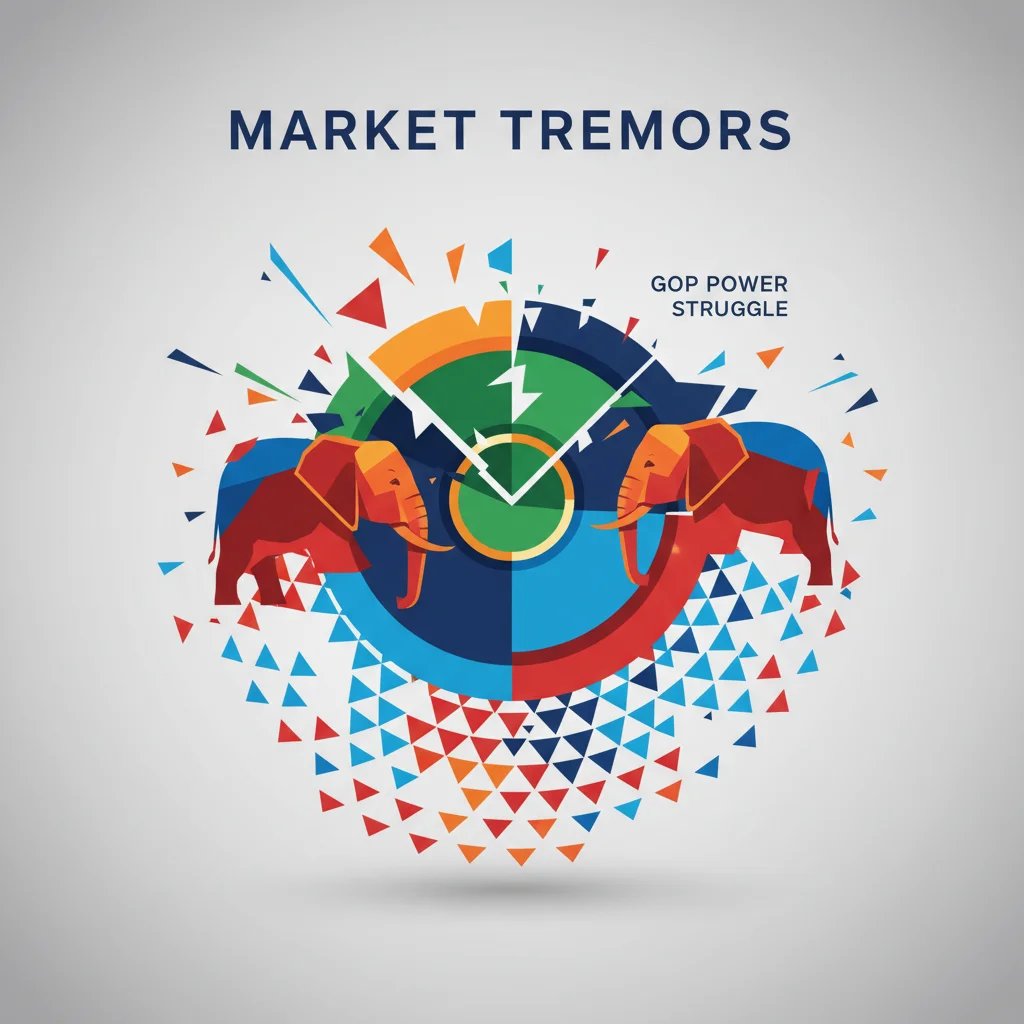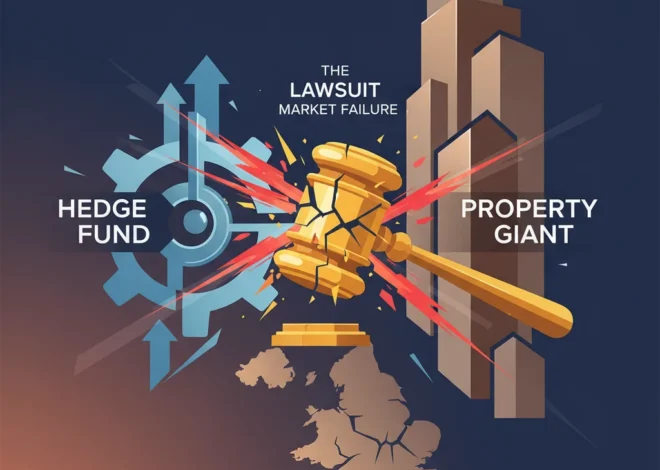
Market Tremors: How a GOP Power Struggle Could Reshape Your Investment Portfolio
In the world of finance, it’s easy to dismiss the daily churn of political headlines as mere noise. Yet, every so often, a story emerges from the political arena with the potential to create significant tremors across the stock market, economy, and the broader investment landscape. The ongoing battle for control of the Republican party’s influential MAGA movement, newly inflamed by revelations from the late Jeffrey Epstein’s private communications, is one such story. What may appear as a purely political drama is, in fact, a critical indicator of future economic policy, regulatory stability, and market volatility.
For investors, business leaders, and finance professionals, understanding the nuances of this intraparty schism is not about picking a political side; it’s about strategic risk assessment. The fault lines being exposed today could determine the direction of American economics for years to come, influencing everything from international trade and banking regulations to the very technology underpinning our financial systems. This analysis will dissect the conflict, explore its direct and indirect economic consequences, and offer a playbook for navigating the uncertainty it creates.
The Anatomy of a Political Fault Line
At its core, the conflict is a struggle over leadership and ideology within one of America’s two major political forces. On one side, former President Donald Trump is working to consolidate his authority, ensuring the “Make America Great Again” movement remains synonymous with his personal brand and political agenda. On the other, a less unified but influential group of donors, strategists, and media figures is exploring a future that, while still populist, may not be exclusively tethered to Trump.
The latest flashpoint in this rift comes from an unlikely source: newly published messages from the late sex offender Jeffrey Epstein. These communications have pulled prominent figures, including billionaire investor Bill Ackman, into the fray. According to a report from the Financial Times, messages reveal Epstein’s attempts to connect with and leverage his network of powerful individuals. The fallout has been weaponized by different factions, with pro-Trump activists using the connections to paint rivals as part of a corrupt “establishment,” while others see it as a distraction from core policy debates. This episode highlights how personal controversies are being used as proxies in a larger war for the soul of the movement.
This internal division is more than just political theater. It creates profound uncertainty about the future policy platform of the Republican party. Will it double down on the protectionist trade policies and deregulation of the Trump years, or will it pivot towards a more traditionally conservative, pro-business, and free-market approach favored by many of its high-profile donors? The answer has massive implications for the global economy and the stock market.
Beyond the Balance Sheet: A Royal Lesson in Strategy from Queen Elizabeth II
From Political Infighting to Economic Volatility
For investors, political uncertainty is a primary driver of market volatility. When the direction of a major party is in question, so too is the future of taxation, regulation, government spending, and international relations. This schism presents two divergent economic paths, each with its own set of winners and losers across various sectors.
To clarify the potential economic stakes, let’s compare the competing visions that are implicitly at the heart of this power struggle:
| Economic Policy Area | Trump-Loyalist Populist Wing | “Post-Trump” Donor / Establishment Wing |
|---|---|---|
| Trade & Tariffs | Favors aggressive use of tariffs to protect domestic industry; views trade as a zero-sum game. Potential for renewed trade wars. | Generally supports free trade agreements and a more predictable, rules-based international economic order. |
| Fiscal Policy | Emphasis on tax cuts, but less concerned with national debt. Government spending can be high on favored projects. | Traditionally focused on fiscal conservatism, debt reduction, and balanced budgets. |
| Banking & Regulation | Aggressive deregulation across sectors, including finance, to spur growth. Potential for political pressure on the Federal Reserve. | Supports a stable and predictable regulatory environment for banking, but may also favor some deregulation. Respect for Fed independence. |
| Technology & Fintech | Views large tech companies with suspicion (antitrust). Focus on domestic tech dominance. | Pro-innovation, supporting financial technology and a competitive landscape with less direct government intervention. |
As the table illustrates, the outcome of this struggle could lead to vastly different environments for investing and trading. A victory for the loyalist wing could benefit domestically-focused manufacturing at the expense of multinational corporations, while a shift towards the donor wing’s preferences might boost international stocks and create a more stable environment for the banking sector. The current state of flux means investors must price in the risk of both scenarios, leading to higher volatility in the near term.
The Financial Technology of Modern Political Movements
The battle for control is also being fought on a digital and financial frontier. Modern political movements are deeply intertwined with financial technology (fintech). Grassroots fundraising, a cornerstone of the MAGA movement’s success, relies on sophisticated online payment platforms, data analytics, and targeted digital advertising. A schism within the movement could lead to a fracture in this lucrative fundraising apparatus. We could see the emergence of competing donor platforms and financial networks, each aligned with a different faction, creating a “fintech civil war” for the dollars of supporters.
This has direct implications for the business of politics and the technology companies that serve it. Furthermore, the populist distrust of established institutions, a key theme in this conflict, sometimes extends to the traditional banking system. While not a mainstream solution, conversations around decentralized finance and blockchain technology often emerge in these circles as a way to promote transparency and circumvent established financial gatekeepers. The ongoing drama, which centers on accusations of elite corruption, could inadvertently fuel interest in technologies that promise a more transparent and decentralized way of handling transactions and data, including political donations.
Crypto's Identity Crisis: Beyond the "Unseemly Land Grab" to a New Financial Future
The efficiency of a political party’s financial technology stack is a key determinant of its power. A divided and competing infrastructure would not only dilute fundraising effectiveness but also signal to large institutional donors a lack of cohesion, potentially causing them to withhold capital until a clear leader and a coherent economic message emerge.
An Investor’s Guide to Navigating Political Headwinds
While the political landscape remains unpredictable, investors are not powerless. A strategic approach to portfolio management can help mitigate the risks associated with this type of uncertainty. The principles of sound investing become even more critical during times of political flux.
1. Emphasize Diversification: A fractured political environment can lead to sector-specific shocks. A policy that benefits domestic steel manufacturers may harm technology companies reliant on global supply chains. A well-diversified portfolio across asset classes, geographies, and industries is the first line of defense against unpredictable policy shifts.
2. Focus on Quality Fundamentals: Companies with strong balance sheets, consistent cash flow, and low debt are better positioned to weather economic storms, regardless of who is in power. During uncertain times, the market tends to reward quality and stability over speculative growth.
3. Monitor Key Economic Indicators: Rather than reacting to every political tweet or headline, focus on the underlying economics. Keep a close watch on inflation data, Federal Reserve statements, trade balances, and consumer sentiment. These metrics provide a clearer picture of the health of the economy than the day-to-day political drama.
4. Understand Your Regulatory Exposure: Sectors like banking, energy, healthcare, and technology are highly sensitive to regulatory changes. Investors should assess their portfolio’s exposure to these sectors and understand how different political outcomes could impact their holdings. The debate over the future of banking regulation, for instance, is a central issue in the background of this power struggle (source).
Sizewell C: A Multi-Billion Pound Bet on Britain's Energy and Economic Future
Conclusion: The Intersection of Power, Politics, and Portfolios
The fight for control over the MAGA movement is far more than a political spectacle. It is a leading indicator of the future of American economic policy and a significant source of risk and opportunity for the financial markets. The outcome will shape everything from international trade relations and the stock market’s performance to the regulatory framework governing the banking and fintech industries.
For investors and business leaders, the key is not to predict the outcome but to prepare for the uncertainty. By understanding the divergent economic philosophies at play, focusing on strong fundamentals, and maintaining a diversified, long-term perspective, it is possible to navigate the volatility and position a portfolio to withstand the political tremors ahead. The headlines will continue to generate noise, but the underlying economic implications are what will ultimately impact the bottom line.


